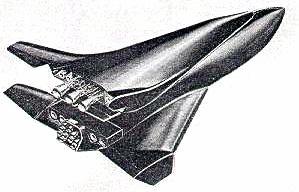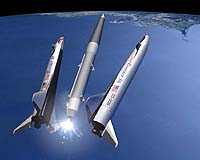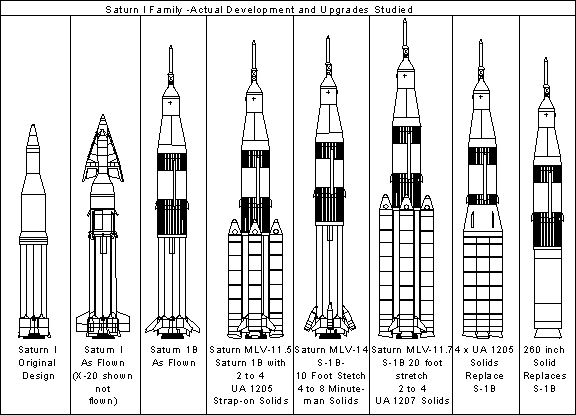New Mars Forums
You are not logged in.
- Topics: Active | Unanswered
Announcement
#29451 Re: Interplanetary transportation » Da Vinci in the Running - Let the Space Race Begin! » 2004-08-17 10:10:53
A study done by Futron corporation on Space tourism and marketing.
http://www.futron.com/spacean....ult.htm
#29452 Re: Human missions » Rocket Business model for shuttle delta IV atlasV - and others good or bad » 2004-08-17 10:08:34
Also on the Futron sire is a study on the Orbital Space Travel & Destinations with Suborbital Space Travel.
#29453 Re: Human missions » Rocket Business model for shuttle delta IV atlasV - and others good or bad » 2004-08-17 10:06:08
Found on the Futron site a history of the X-33 or the OSP project.
#29454 Re: Human missions » Hubble mistake - Action needed » 2004-08-17 09:56:36
Nasa News Release : The Marshall Center has been selected as the site of NASA's Discovery and New Frontiers Program Office.
http://www.msfc.nasa.gov/news/news/rele … 4-214.html
Marshall gets planet probe assignment
Center will manage, send missions for robotic explorations.
http://www.al.com/news....180.xml
What impact will this change of operations for Marshall Center have in the long run?
#29455 Re: Human missions » Rocket Business model for shuttle delta IV atlasV - and others good or bad » 2004-08-17 09:53:20
Bwhite supplied a link to the Futron Corporation Space Transportation Costs: http://www.futron.com/pdf/FutronLaunchCostWP.pdf
#29456 Re: Human missions » Cheap heavy launcher - can it be done at all » 2004-08-17 09:50:26
Thanks BWhite for the cost link to Space Transportation Costs
of Futron Corporation for the other thread on Rocket Business model for shuttle delta IV atlasV, and others good or bad.
#29457 Re: Human missions » China The Dominant Superpower In 20 Years..... - What does this mean for US? » 2004-08-17 09:41:16
In 20 years, china will be a different nation due to the feeling of democracy and freedoms that will come from individuals that visit free nations. Just look at the changes that have occured to the old soviet block nations and to Russia.
#29458 Re: Human missions » Hubble mistake - Action needed » 2004-08-17 09:36:46
What would it take to place a skylab sized module just for that purpose near the Hubble?
#29459 Re: Science, Technology, and Astronomy » ISS cutbacks » 2004-08-17 06:25:52
Now here is a real surprise of science being done on the ISS.
Soldering Surprise
There's nothing routine about working in space, as astronaut Mike Fincke found out recently when he did some soldering onboard the International Space Station.
http://science.nasa.gov/headlines/y2004 … solder.htm
So we actually can build things in space if given the tools. Who would have thought it.
#29460 Re: Science, Technology, and Astronomy » ISS cutbacks » 2004-08-17 05:52:26
Ya lots of failed programs in the x series, tons of demonstrators or mock ups and the closest they came to something that was off the shelf and re-usuable was the DX.
Way to go Nasa, nothing like a workfare program.
#29461 Re: Human missions » China The Dominant Superpower In 20 Years..... - What does this mean for US? » 2004-08-17 05:31:39
But the one thing they have lots of is cheaper labor and american businesses love to farm out just about everything in order to make a buck.
#29462 Re: Science, Technology, and Astronomy » Masten, new contender in the RLV market - Looks at DC-X an RVT as inspiration. » 2004-08-16 20:53:29
Xprize contest team that has a simular looking rocket.
http://www.xprize.org/teams/american_acceleration.php
#29463 Re: Human missions » Cheap heavy launcher - can it be done at all » 2004-08-16 20:32:37
When I think of heavy lift I do not assume only cargo or of very large size modules. As I noted before I was referencing the need for more than a few astronauts with enough materials to maybe transfer into any such earlier launched Habitat modules.
The Progress is currently carrying to the Iss about 2.5 tons of food, water, propellant, and other supplies for its two-man crew.
How long do you think those supplies will last with a real size crew for exploration to mars or to the moon.
Just think about how many people would be on this journey and for how many months that the journey wil be fore not to mention the number of months they will be there in addition to the return trip.
If one does puny little capsulse for a max of 3. What then leave them parked in orbit for the four or 5 yearfor the round trip. I would hope not. I also do not see that many docking ports on a habitat module either. Not to mention bringing those capsules all the way to Mars or the moon, One would be bad enough.
Sorry If I am way off topic of cargo lift only.
#29464 Re: Human missions » Cheap heavy launcher - can it be done at all » 2004-08-16 14:24:48
We have talked about every thing but the manned portion of the rocket. As every one has noted it is fairly easy to design something to lift materials or other items to almost anywhere that we would want.
Man is the problem that still needs a real solution when it comes to space flight.
We could say use a capsule like; Big gemini or apollo, a small lifting body as in lockheeds concept art or from some of the x series vehicles and some would continue to say a plane format is the way to go.
We need this part of the solution today in order to retire the shuttle to only cargo mode and completion of the ISS.
I still believe that the wieght of this issue needs to be resolved by Nasa's current rocket vendors and not be issueing more contracts for what is already known to be of need.
#29465 Re: Human missions » MarsDirect or Mars Sustained ? » 2004-08-16 14:16:36
Cash flow is the only reason that we are not looking at this.
Building of the infrastucture to start the process is a must.
Finding some way to not only design a cheaper rocket but one that is less costly to operate is also a must.
#29466 Re: Human missions » Cheap heavy launcher - can it be done at all » 2004-08-16 13:53:55
Last I knew aerodynamics has to due with surface area and angles relative to direction. Hence the more surface area the more drag.
#29467 Re: Interplanetary transportation » Da Vinci in the Running - Let the Space Race Begin! » 2004-08-16 13:01:51
Try, try again: Space Transport Corp http://www.space-transport.com/ ., the Washington-based rocket team whose rocket blew up last weekend, is targeting Sept. 12 for the next test launch from the Olympic Peninsula, says Phillip Storm, the company's president.
"We’re going to fabricate two more identical Rubicon rockets. ... We're going to do another engine test in early September," Storm writes in an e-mail.
Storm says telemetry from the launch of Rubicon 1 indicates that the attitude control system "was fighting to keep it straight, even though the rocket was being torn apart."
"The rocket held in there pretty good even though one of the engines exploded," Storm writes. "I’m fairly confident a pilot could have thrown the parachute and been OK. The capsule was catastrophically damaged only on impact with the water. We’ll come up with some extra safety measures to ensure a command is sent for parachute deployment in the event of a failure."
#29468 Re: Space Policy » Space fairing Nations - The ever changing view » 2004-08-16 12:24:06
'Beagle 3' looks to American ride
http://news.bbc.co.uk/1/hi/sci/tech/3926253.stm
But even if they do not get to do another follow up mission to the failed attempt. The European Space Agency is planning its own lander mission, called ExoMars, to look for traces of life on the Red Planet. This might also launch in 2009.
#29469 Re: Human missions » Cheap heavy launcher - can it be done at all » 2004-08-16 12:03:00
Here is the other one that I had seen from the Next generation or SLI work that has been recently canned. It seems like most of the Nasa links are now gone to this info.

NASA Working with Contractors to Explore Shuttle Successor
http://dev.space.com/missionlaunches/fl_021030a.html
#29470 Re: Human missions » Cheap heavy launcher - can it be done at all » 2004-08-16 11:51:00
I could not help but notice the simularities to the Space Launch Initiative's vehicle and this one.

SLI Explores Flyback Booster Possibilities
http://www.spacedaily.com/news/rocketscience-02u.html
It is to bad that some programs have been cancelled that could have been the solution to the delma that we are in.
#29471 Re: Human missions » Rocket Business model for shuttle delta IV atlasV - and others good or bad » 2004-08-16 11:42:51
You are right if the price per unit is not effected by building by an assembly line process though automation versus by hand for a fix quantity of build. But that is just part of the problem is that high cost of build.
#29472 Re: Space Policy » Space fairing Nations - The ever changing view » 2004-08-16 10:21:42
India To Launch Recoverable Spacecraft In 2005
http://www.spacedaily.com/news/india-04l.html
#29473 Re: Human missions » Cheap heavy launcher - can it be done at all » 2004-08-16 10:07:09

To take a page out of what the Russians continued to do with their soyuz space craft. They made continued changes and enhancemens as need to keep there rockets flying and are still doing so today.
While america kept changing the rocket platform in large jumps or into other design concepts each time.
#29474 Re: Human missions » Rocket Business model for shuttle delta IV atlasV - and others good or bad » 2004-08-16 08:55:03
The intent of my thread was to give a cost based analysis as to what should be the avenue of choice. What should be the cheaper heavy lift launcher developement and manufacturing cost to create infrastructure for the future. Based on the current rockets as models for what not to do.
Large protoype design cost and over runs
Cost over runs to solidly consistant manufacturing of expendable rocket designs
Cost over runs for refurbishment of re-usable craft designs
Operations launch cost
Workfare when staff is not really working but is idle
Questions for those that know more about the Lockheed and of Boeing rockets.
Does either launch there own rockets for profit?
What is there work staff base for carrying on these facets of infrastruture?
From earlier in another thread using the RD-170 versus the F1 of the Saturn is a good choice for a first stage engine.
This sort of sound like a Saturn 1 or V re-du derivative only modernized for a business model using what is a close match for the old specification.
#29475 Re: Human missions » Cheap heavy launcher - can it be done at all » 2004-08-16 08:35:37
From earlier in the thread using the RD-170 versus the F1 of the Saturn is a good choice for a first stage engine.
This sort of sound like a Saturn 1 or V re-du derivative only modernized for a business model using what is a close match for the old specification.